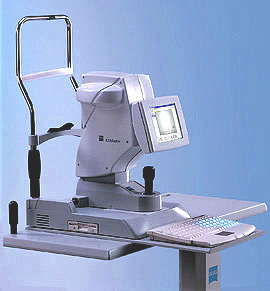Selecting Your Implant Lens Power
Expectations for most patients
With routine cataract surgery, you will likely need to wear glasses after the cataract extraction procedure for either distance or reading vision or both in order to get the best possible vision. On the other  hand, carefully selected patients receiving monovision or new multifocal or accommodating type implants will generally be MUCH LESS DEPENDENT on glasses. You should discuss with your doctor any questions you have about how your vision will be with and without glasses after cataract surgery. You and your doctor will make a plan together to best fit your needs. Here are some general considerations: “Perfect” vision without glasses after cataract surgery is NOT to be expected. Nonetheless, there are ways to try to make a closer match between your visual lifestyle and your uncorrected vision.
hand, carefully selected patients receiving monovision or new multifocal or accommodating type implants will generally be MUCH LESS DEPENDENT on glasses. You should discuss with your doctor any questions you have about how your vision will be with and without glasses after cataract surgery. You and your doctor will make a plan together to best fit your needs. Here are some general considerations: “Perfect” vision without glasses after cataract surgery is NOT to be expected. Nonetheless, there are ways to try to make a closer match between your visual lifestyle and your uncorrected vision.
If diminished dependency on glasses would be of interest to you
There are options to consider: For some patients Toric lenses or “multifiocal” lens technology lens may be appropriate. Another option is “Monovision.” Click here to watch a short movie on these topics.
Once the TYPE of implant is selected, the POWER needs to be selected
Tools we use for consistent results
“Perfect” results of your implant power calculation are NOT 100% predictable. Laser refractive surgery (LASIK, for example) is more precise in that regard, but the refractive laser is unable to remove cataracts. Nonetheless, there are some ways to try to get more consistently CLOSE to the exact power prediction for your lens implant. At MarinEyes, our technicians are thoroughly trained and very careful; our technicians have measured an estimated 10,000 eyes! The measuring devices we use include the IOL Master, a laser scanning device to measure the length and curvature of your eye. We also use a method called “Immersion A-Scan” on some of our patients. These methods are more accurate than the “Contact A-Scan.” The measurements are run through special computer software to model the best-fit lens implant for your goals. We use one or more of several programs (Hoffer-Q, Holladay I, SRK-T, Haigis and Haigis-L, and the Holladay II software) for each surgery, and specialized online calculators for astigmatism correcting Toric IOLs. This is a dynamic area, and we work very hard to attain excellent results.
Why IOL power prediction results may vary from expected
IOL Power prediction and selection is a demanding process. It starts with an understanding of the patient’s desires, translated into a “refractive goal” and the selection of a primary lens implant. Backup lenses are also selected in case they are needed. The measurement process is also very exacting, and can be disturbed by such things as dry eye, corneal scars or prior refractive (LASIK od RK) surgery. Our measurement instruments are frequently calibrated. Finally, we must use mathematical formulas to convert the goal and the measurements into a lens power selection. These formulas make certain assumptions about all eyes, and about the particular eye depending on the measured dimensions. Furthermore, eyes that have had previous refractive surgery are extremely difficult to predict because there are additional variables introduced. There are some guidelines, as well as some art in selecting which formula to use for a given patient.
There will be a small error inherent in each of these steps, despite every effort to minimize variance. Fortunately, these small errors will usually cancel each other out, so our results cluster very closely about the goal. Occasionally, however, these errors will stack up in one direction, resulting in a “surprise,” situation in which the actual post-operative refractive error is significantly different from the desired goal for that patient. When this happens, the options for management may include: accept the result, and use glasses (or contact lens) to adjust; insert a compensatory “piggyback” IOL behind the iris, just in front of the original lens (an operating room procedure); use LASIK, PRK or Epi-LASIK to correct the problem; or, exchange the IOL in the operating room.
To be complete, packaging or clerical errors have occasionally been the cause of IOL power being incorrect. At MarinEyes we go to great lengths to prevent this kind of error.
In sumary, while it is possible for errors to lead to an IOL power result different from the goal, the cause more often lies in one of the issues presented on this page.